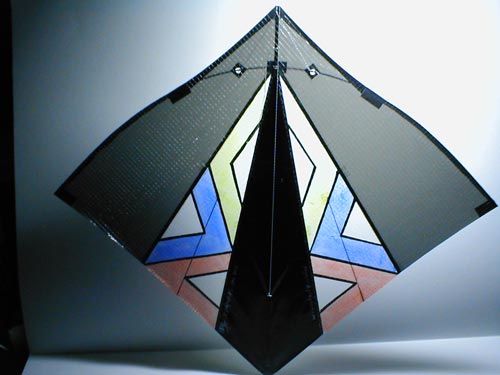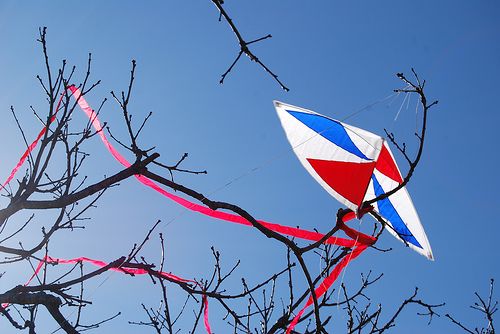Kite Fighting
North American Style!
Perhaps you have heard of kite fighting, particularly in the context of Indian or Afghan flying. The latter was given a big publicity boost by the movie "The Kite Runner," of course!
As I have touched on in other pages on this site, some traditional Asian contests involve the cutting of your opponent's string with gulp ... ground glass pasted onto the line!
But what about North America? Well, the sport has taken off there too. At first, it was mainly people copying the traditional types of fighting contests from Asia. However, a uniquely American kite-fighting scene has developed since the late 1990s. The photo down there is courtesy of the AKA (American Kitefliers Association).
 The Resnik—a modern Western fighter
The Resnik—a modern Western fighterTo sum up, here are some of the differences:
- The kites are generally quite small, being about 18 inches in height. With the curved cross spar and roughly square diamond shape, the Indian influence is clear!
- The kite sail often has two small battens attached near the tail end, defining a wedge-shaped area of sail.
- Bridles with more than the traditional two legs are common, for smoother flight characteristics. I must admit this took me by surprise, since I have always associated complex bridles with much larger kites.
- Modern materials predominate for both sails and spars although split bamboo is sometimes used as well.
- A "line touch" concept is the basis for competition rather than line cutting!
With these kites, the curved cross spar is often referred to as the bow and the vertical spar, the spine. Also, the sail is often referred to as the skin.
Instability is the key to controlling these kites, so they don't have tails. Pulling on some line tension causes the kite to fly in a straight line. At other times, it tends to fly around in tight circles!
On this site, there's more kite-making info than you can poke a stick at. :-)
Want to know the most convenient way of using it all?
The Big MBK E-book Bundle is a collection of downloads—printable PDF files which provide step-by-step instructions for many kites large and small.
Every kite in every MBK series.
Kite-fighting types like to think that their sport extends the flying to three dimensions. Well, I guess that's true when compared to sport kites.
However, I happen to think that thermaling with single-liners is a genuinely 3D affair too! This is possible with, for example, a big light-wind rokkaku. At times you have no option but to pull down the kite almost to within arm's reach before catching another gust, another patch of warm air, right back up to 400 feet.
Oops, this is getting off-topic here. ;-) Back to North American fighters...
Other traditional kite types are also the basis for inspiration. For example, there is the Japanese rokkaku. The American versions tend to be smaller and use modern materials. Speaking of materials, here's a fairly comprehensive list of what can be used to create a modern fighter kite:
Spar Materials
- carbon-fiber rods
- fiberglass rods
- split bamboo
Batten Materials
- carbon-fiber rods
- fiberglass rods
- coffee-stirrer straws
- drinking straws
- split BBQ-skewers
- split bamboo
Sail Materials
- ripstop nylon
- plastic sheet
- Mylar
- Orcon
- gift wrap
- Clearphane
- floral-wrap films
- Cellane
These kites are not really beginners' projects, in the sense
that they tend to use a variety of tools and techniques. Several hours
of careful work is required to turn out a neatly and accurately made craft. Some designs make an attempt to simplify things for the
beginner, though, with a claimed build time of just two hours or so.
It's certainly true that the smaller the kite, the harder it is to get the dimensions accurate enough. Not being a great craftsman, that's one reason why I prefer big kites!
Kite-Fighting Games
Of course there are online games now that simulate kite fighting! This is just like practically every other sport on the planet.
KiteFights are a crowd that take their simulations fairly seriously. :-)
Kite Fighting in a Line-Touch Bout
The increasingly popular "line touch" form of competition is a real contrast to the traditional line-cutting scenario. For one thing, all the action happens on relatively short lines. Compare this to the kids in India or Afghanistan who fly their kites so high and far away that they are almost dots in the sky! Thousands of feet of line go out.
In line-touch kite fighting, two competitors stand in two circles on the ground. When the call "bottom" or "top" is made, each flier attempts to touch his or her flying line with the other person's line. Supposing "top" was called. In that case, the owner of the top line during the next touching of lines wins a point.
The aim, of course, is to gain more points than your opponent. It's safer than lopping off birds' wings and people's ears with glass-coated line. OK, that's a slight exaggeration, but the wax-coated cotton lines these line-touch guys (and girls) use is definitely safer!
What better place to go than the North American Fighter Kite Association if you want more info on the kite-fighting scene there. That's their official site.
Here's a typical fighter kite, which ended up in a tree. Perhaps this
kite flew more like an ordinary single-liner, though; see how much tail the owner had added!
The video below shows a complete kite-fighting bout that took place at the Adelaide International Kite Festival. OK, so it's not
North America. However, I'm sure a number of similar rok battles would
take place in various events and festivals across the USA each year. At
least the video shows some real non-traditional Western kite-fighting.
Even if the rokkakus are painted with Japanese characters.
As mentioned earlier, there's more kite making on this site than you can poke a stick at. :-)
Want to know the most convenient way of using it all?
The Big MBK E-book Bundle is a collection of downloads—printable PDF files that provide step-by-step instructions for many kites large and small.
That's every kite in every MBK series.

